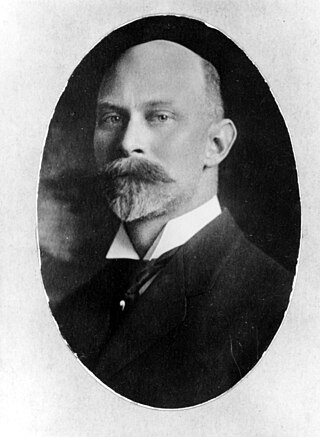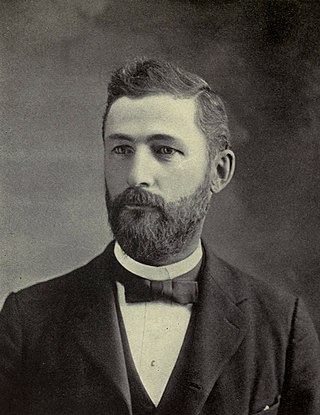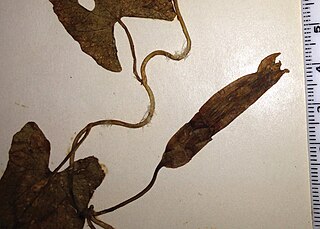Related Research Articles

Henry Smith Pritchett was an American astronomer and educator.

Theodore William Richards was the first American scientist to receive the Nobel Prize in Chemistry, earning the award "in recognition of his exact determinations of the atomic weights of a large number of the chemical elements."
Frederic Edward Clements was an American plant ecologist and pioneer in the study of plant ecology and vegetation succession.

Wanda K. Farr was an American botanist known for her discovery of the mechanism by which cellulose is formed in the walls of plant cells.

John Ernst Weaver was an American botanist, prairie ecologist, and university professor.

Susan Randi Wessler, ForMemRS, is an American plant molecular biologist and geneticist. She is Distinguished Professor of Genetics at the University of California, Riverside (UCR).
The Carnegie Institution of Washington, known also for public purposes as the Carnegie Institution for Science (CIS), is an organization in the United States established to fund and perform scientific research. The institution is headquartered in Washington, D.C. As of June 30, 2020, the Institution's endowment was valued at $926.9 million. In 2018 the expenses for scientific programs and administration were $96.6 million. Eric Isaacs is president of the institution.

Florence Elizabeth Meier Chase was an American botanist who researched the interaction of sunlight and algae at the Smithsonian. She was a fellow of the American Association for the Advancement of Science and an honorary member of the Washington Botanical Society. She was married to Dr. William Wiley Chase and also assisted in his publication of articles on scientific and medical topics.

Thomas Wayland Vaughan was an American geologist and oceanographer. He worked with the United States Geological Survey and United States National Museum, investigating the geology of the West Indies, Panama Canal Zone, and the eastern coast of North America. In 1924 Vaughan became director of the Scripps Institution of Oceanography and held the post until his retirement in 1936. His research work concentrated on the study of corals and coral reefs, the investigation of larger foraminifera, and oceanography.
Ethel (Nicholson) Browne Harvey was an American embryologist, known for her critical findings about cell division, using the embryology of sea urchins, and for early work studying embryonic cell cleavage.

Frank Leverett was an American geologist who specialised in glaciology.
Harvey Monroe Hall was an American botanist particularly noted for his taxonomic work in the western United States.
Edwin Broun Fred was an American bacteriologist and academic who was the 15th president of the University of Wisconsin–Madison, serving from 1945 to 1958. Born in Virginia, Fred studied at the Virginia Polytechnic Institute and the University of Göttingen. After briefly teaching at Virginia Polytechnic, Fred took a position with Wisconsin. He was dean of the graduate school from 1934 until 1943, then was dean of the College of Agriculture until 1945. He ascended to the presidency and was known for his response to the postwar growth in admissions. Fred was the president of the Society of American Bacteriologists in 1932.

Caroline Priscilla Bingham was an American botanist who was one of the earliest American women to publish scientific papers on botany. She was an influential collector of botanical specimens discovering a new genus and several new species. As a result of her discoveries Bingham had a genus and several algae species named in her honor.
Frances Gertrude Wick was an American physicist known for her studies on luminescence.

Edith Gertrude Clements (1874–1971), also known as Edith S. Clements and Edith Schwartz Clements, was an American botanist and pioneer of botanical ecology who was the first woman to be awarded a Ph.D. by the University of Nebraska. She was married to botanist Frederic Clements, with whom she collaborated throughout her professional life. Together they founded the Alpine Laboratory, a research station at Pikes Peak, Colorado. Clements was also a botanical artist who illustrated her own books as well as joint publications with Frederic.
Effie Almira Southworth Spalding (1860–1947), was an American botanist and mycologist, and the first woman plant pathologist hired by the United States Department of Agriculture (USDA). Her most important discovery was the 1887 identification of the fungus Colletotrichum gossypii as the cause of cotton cankers, a disease which killed thousands of acres of cotton and was a major economic threat. She taught botany at several institutions, worked at the Desert Botanical Laboratory with her husband, and established the Botany Department Herbarium at the University of Southern California.
Miriam Lucile Bomhard was a conservationist and botanist from the United States of America. She was the first woman to receive a PhD from the University of Pittsburgh.

Elizabeth Nesbitt, also known as Betty Nesbitt was an American children's librarian and a library science educator. She was known “internationally as an authority on children's literature”, and made “(s)trong contributions” to children's librarianship.
Oliver Holmes Gish was an American geophysicist, known for his research on atmospheric electricity and earth currents. He "contributed to our understanding of magnetic storms and the daily variation of the geomagnetic field."
References
- 1 2 3 4 5 6 "plantphysiol.org" (PDF).
- 1 2 Biodiversity Heritage Library
- ↑ "worldcat.org".
- ↑ Hall, Harvey Monroe (March 19, 1921). Rubber-content of North American plants. Carnegie Institution of Washington publication313. Washington. hdl:2027/hvd.32044107279952.